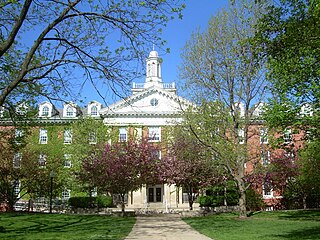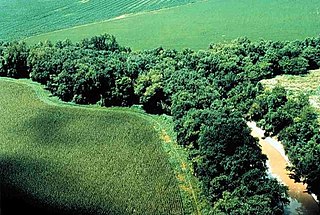
The Chavez Ravine Arboretum, in Elysian Park, just north of Dodger Stadium, at 929 Academy Road, Los Angeles, California, contains more than 100 varieties of trees from around the world, including what are believed to be the oldest and largest Cape Chestnut, Kauri, and Tipu trees in the United States. Admission to the arboretum is free.

The University of Delaware Botanic Gardens are botanical gardens and an arboretum located on the campus of the University of Delaware, in Newark, Delaware, United States. The gardens are open to the public without charge.

The Donald E. Davis Arboretum is an arboretum located on the campus of Auburn University in Auburn, Alabama. It is open to the public without charge.
The Alice Abel Arboretum is a 25 acres arboretum located at 5000 St. Paul Street on the campus of Nebraska Wesleyan University in Lincoln, Nebraska.

The Fell Arboretum is an arboretum located across the campus of Illinois State University in Normal, Illinois.

A riparian zone or riparian area is the interface between land and a river or stream. Riparian is also the proper nomenclature for one of the terrestrial biomes of the Earth. Plant habitats and communities along the river margins and banks are called riparian vegetation, characterized by hydrophilic plants. Riparian zones are important in ecology, environmental resource management, and civil engineering because of their role in soil conservation, their habitat biodiversity, and the influence they have on fauna and aquatic ecosystems, including grasslands, woodlands, wetlands, or even non-vegetative areas. In some regions, the terms riparian woodland, riparian forest, riparian buffer zone,riparian corridor, and riparian strip are used to characterize a riparian zone. The word riparian is derived from Latin ripa, meaning "river bank".

Peavy Arboretum is an arboretum operated by Oregon State University and located on Arboretum Road, Corvallis, Oregon. It is open to the public daily without charge.
The Museo e Arboreto Carlo Siemoni is a museum and historic arboretum located in Badia Prataglia, Poppi, Province of Arezzo, Tuscany, Italy.

Weeping trees are characterized by soft, limp twigs. This characterization may lead to a bent crown and pendulous branches that can cascade to the ground. While weepyness occurs in nature, most weeping trees are cultivars. Because of their shape, weeping trees are popular in landscaping; generally they need a lot of space and are solitary so that their effect is more pronounced. There are over a hundred different types of weeping trees. Some trees, such as the cherry, have a variety of weeping cultivars. There are currently around 550 weeping cultivars in 75 different genera, although many have now disappeared from cultivation.
This is an alphabetical list of useful timber trees, indigenous and exotic, growing in the Gauteng area of South Africa. These trees range in size up to some 1.5m DBH, such as Cedrus deodara, the Himalayan Cedar. Hobbyists will seek out even small pieces of highly valued timber, such as Buxus macowanii, the South African counterpart of Buxus sempervirens, for turnery or the making of boxes and small items. Despite the wealth of useful woods available in Gauteng, most of the trees, felled or fallen, are dumped or cut into short lengths for fuel. Trees grown in urban or suburban environments are rarely pruned and are consequently often knotty. Timber frequently holds nails, wire and spikes, attesting to a variety of abuse during the lifetime of a tree, and requiring the use of a metal detector by the sawmiller. Garden cuttings and dead leaves are occasionally piled next to trees and burnt, leaving charred scars and inclusions.

Muellerina eucalyptoides, commonly known as creeping mistletoe, is a hemiparasitic arial shrub in the family Loranthaceae. The species is endemic to Australia. M. eucalyptoides is pendulous in habit, unlike other Muellerina species, but has the long epicortical runners of all Muellerina species.

Xanthoparmelia lineola, commonly known as the tight rock-shield, is a foliose lichen species in the genus Xanthoparmelia. It is a common species with a temperate distribution. Found in North America and South Africa, it grows on rocks.










